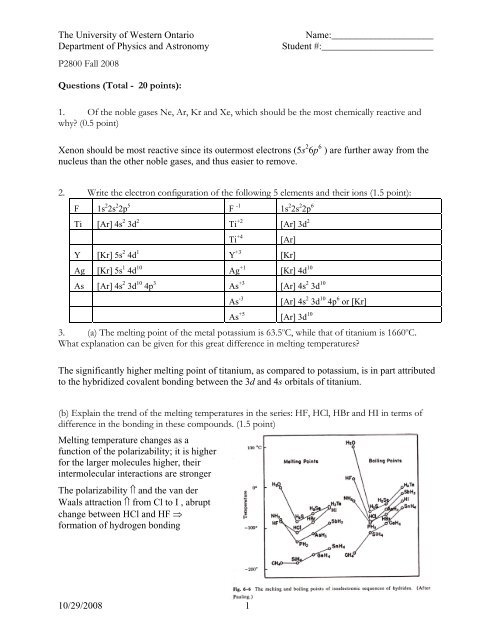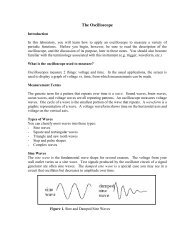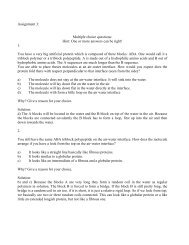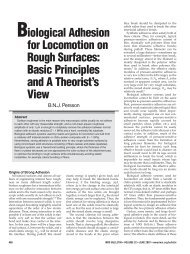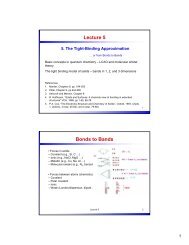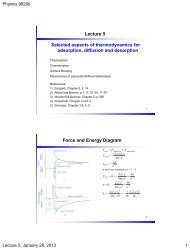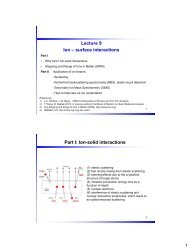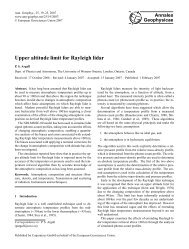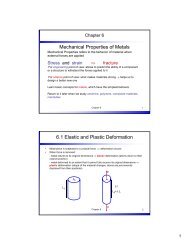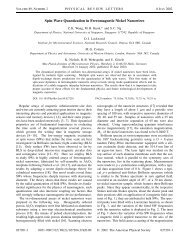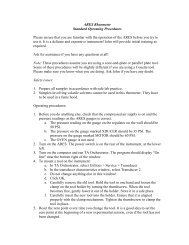Midterm Exam Solutions - Physics and Astronomy - University of ...
Midterm Exam Solutions - Physics and Astronomy - University of ...
Midterm Exam Solutions - Physics and Astronomy - University of ...
Create successful ePaper yourself
Turn your PDF publications into a flip-book with our unique Google optimized e-Paper software.
The <strong>University</strong> <strong>of</strong> Western OntarioDepartment <strong>of</strong> <strong>Physics</strong> <strong>and</strong> <strong>Astronomy</strong>P2800 Fall 2008Name:_____________________.Student #:_______________________.Questions (Total - 20 points):1. Of the noble gases Ne, Ar, Kr <strong>and</strong> Xe, which should be the most chemically reactive <strong>and</strong>why? (0.5 point)Xenon should be most reactive since its outermost electrons (5s 2 6p 6 ) are further away from thenucleus than the other noble gases, <strong>and</strong> thus easier to remove.2. Write the electron configuration <strong>of</strong> the following 5 elements <strong>and</strong> their ions (1.5 point):F 1s 2 2s 2 2p 5 F -1 1s 2 2s 2 2p 6Ti [Ar] 4s 2 3d 2 Ti +2 [Ar] 3d 2Ti +4[Ar]Y [Kr] 5s 2 4d 1 Y +3 [Kr]Ag [Kr] 5s 1 4d 10 Ag +1 [Kr] 4d 10As [Ar] 4s 2 3d 10 4p 3 As +3 [Ar] 4s 2 3d 10As -3As +5 [Ar] 3d 10[Ar] 4s 2 3d 10 4p 6 or [Kr]3. (a) The melting point <strong>of</strong> the metal potassium is 63.5 o C, while that <strong>of</strong> titanium is 1660 o C.What explanation can be given for this great difference in melting temperatures?The significantly higher melting point <strong>of</strong> titanium, as compared to potassium, is in part attributedto the hybridized covalent bonding between the 3d <strong>and</strong> 4s orbitals <strong>of</strong> titanium.(b) Explain the trend <strong>of</strong> the melting temperatures in the series: HF, HCl, HBr <strong>and</strong> HI in terms <strong>of</strong>difference in the bonding in these compounds. (1.5 point)Melting temperature changes as afunction <strong>of</strong> the polarizability; it is higherfor the larger molecules higher, theirintermolecular interactions are strongerThe polarizability ⇑ <strong>and</strong> the van derWaals attraction ⇑ from Cl to I , abruptchange between HCl <strong>and</strong> HF ⇒formation <strong>of</strong> hydrogen bonding10/29/2008 1
The <strong>University</strong> <strong>of</strong> Western OntarioDepartment <strong>of</strong> <strong>Physics</strong> <strong>and</strong> <strong>Astronomy</strong>Name:_____________________.Student #:_______________________.4. A direction vector passes through a unit cube from point A to point B. What are its directionMiller indices? (1.5 point).(a) A: x = 0.75; y = 0; z = 0.25; B: x=0.5; y = 1; z = 0(b) A: x = 1; y = 1; z = 0; B: x=0.25; y = 0; z = 1(c) A: x = 1; y = 0; z = 1; B: x=0; y = 1; z = 1(a) [ 141 ](b) [ 344](c) [ 110]5. What are the Miller indices <strong>of</strong> the cubic crystallographic planes shown in Figure 1? (1 point)Figure 1.(a) use (1, 0, 1) as origin; intercepts: x=-1, y = ∞, z= -1/3 ⇒reciprocals: -1, 0, -3 ⇒ ( 103)(b) use (0, 1, 1) as origin; intercepts: x=1, y = -1, z= -2/3 ⇒reciprocals: 1, -1, -3/2 ⇒ ( 223)(c) use (0, 0, 0) as origin; intercepts: x=-3/5, y = 1/4, z= ∞⇒reciprocals: 1, -12/5, 0⇒ ( 512 0)(d) use (0, 1, 0) as origin; intercepts: x=1, y = -1, z= 1/2⇒reciprocals: 1, -1, 2 ⇒ ( 112)6. Determine the Miller-Bravais direction indices <strong>of</strong> the 6 vectors (a-f) originating at the center<strong>of</strong> the lower plane <strong>and</strong> ending at the endpoints <strong>of</strong> the upper basal plane as indicated in Figure 2. (1.5point)a) [ 1 121]b) [ 2111]c) [ 1211]d) [ 1121]e) [ 21 11]f) [ 1211]Figure 2.afbecd10/29/2008 2
The <strong>University</strong> <strong>of</strong> Western OntarioDepartment <strong>of</strong> <strong>Physics</strong> <strong>and</strong> <strong>Astronomy</strong>Name:_____________________.Student #:_______________________.7. Determine the Miller-Bravais indices <strong>of</strong> the hexagonal crystal planes a, b, c in Figure 3. (1.5point)a) Intercepts: a 1 =∞, a 2 =1, a 3 =-1, c=∞reciprocals: 0, 1, -1, 0 ( 0110)b) New origin, intercepts: a 1 =1, a 2 =-1, a 3 =∞, c=1reciprocals: 1, -1, 0, 1 ( 1101)c) Intercepts: a 1 =1, a 2 =-1, a 3 =∞, c=1reciprocals: 1, -1, 0 , 1 ( 1101)Figure 38. The lattice constant for bcc tantalum at 20°C is 0.33026 nm <strong>and</strong> its density is 16.6 g/cm 3 .Calculate a value for its atomic mass. (1 point).Density 16.6 g/cm 3 Volume 1 cm 3Mass/unit cell X Volume (0.33026nm) 3 =(0.33026x10 -9 m) 3X = 16.6 g/cm 3 (10 6 cm 3 /m 3 ) (0.33026x10 -9 m) 3 =5.98x10 -22 g/unit cell5.98×10Atomic mass =−22g / unit cell(6.023×102atoms/ unit cell23atoms / mol)= 180.09g/ mol9. Aluminum is diffused into a thick slice <strong>of</strong> silicon with no previous aluminum in it at atemperature <strong>of</strong> 1100°C for 6 h. What is the depth below the surface (in cm) at which theconcentration is 10 16 atoms/cm 3 if the surface concentration is 10 18 atoms/cm 3 ? D = 2 × 10 -12 cm 2 /sfor aluminum diffusing in silicon at 1100°C. Use the value <strong>of</strong> the error function from the tablebelow for a solution (2 point).10/29/2008 3
The <strong>University</strong> <strong>of</strong> Western OntarioDepartment <strong>of</strong> <strong>Physics</strong> <strong>and</strong> <strong>Astronomy</strong>Name:_____________________.Student #:_______________________.10. What 5 factors affect the diffusion rate in solid metal crystals? (0.5 point).1. Type <strong>of</strong> diffusion mechanism;2. Temperature <strong>of</strong> diffusion;3. Concentration <strong>of</strong> the diffusion species (4. Type <strong>of</strong> crystal structure;5. Type <strong>of</strong> crystal imperfections present.11. Based on the data in the table below, is it easier for carbon atoms to diffuse in the bcc ironor in fcc iron? What is the physical reason for this? (Hint: think about the size <strong>of</strong> interstitial sites forfcc <strong>and</strong> bcc structures)(1.5 points)Diffusion is easier in bcc iron (diffusivity is higher, see table above)Consider bcc iron lattice, the atomic radius <strong>of</strong> the Fe is R, <strong>and</strong> the interstitials are at theA: (½, 0, 0), (0, ½, 0), (0, 0, ½), <strong>and</strong> B: (½, ½, 0), positions4R=√3a R=(√3a)/4 or a = (4R)/ √3A interstitials: radius <strong>of</strong> interstitial is r A2R +2r A = a=(4R)/ √32r A = R (4/√3 – 2)r A = R ((2/√3) – 1)=0.154 RB interstitials: radius <strong>of</strong> interstitial is r B2R +2r B = √2 a = (4√2 R)/ √3r B = R (2√2/√3) – 1=0.63 RConsider fcc Fe lattice, the atomic radius <strong>of</strong> the iron is R, <strong>and</strong> the largest interstitials occur at the(½, 0, 0), (0, ½, 0), (0, 0, ½), etc. type positions4R=√2aR=(√2a)/4Interstitials: radius <strong>of</strong> interstitial is r2R +2r = a = (4R)/ √2r = R ( √2 -1) = 0.414 Rbcc: r B = 0.63 R> fcc r = 0.414 R10/29/2008 4
The <strong>University</strong> <strong>of</strong> Western OntarioDepartment <strong>of</strong> <strong>Physics</strong> <strong>and</strong> <strong>Astronomy</strong>Name:_____________________.Student #:_______________________.12. Determine the tensile stress that must be applied to the [ 110]axis <strong>of</strong> a high-purity coppersingle crystal to cause a slip on the ( 11 1)[01 1]system. The resolved shear stress for the crystalis 0.85 MPa. (1.5 points)τrτr= σ cosφcosλ;σ =cosφcosλThe angle λ between [ 110]stress application <strong>and</strong> [ 01 1]slip direction isλ = 60 ocos φ = √2/√3 = 0.8165, φ = 35.3 οσ =0.85MPa= 2. 08MPao ocos60 cos35.313. Twenty-cm-long rod (l 0 = 0.22m) with a diameter <strong>of</strong> 0.250 cm is loaded (vertically) with a5000 N weight. If the diameter decreases to 0.210 cm, <strong>and</strong> assuming that A0 l0 = Ai li ,determine(a) the engineering stress <strong>and</strong> strain at this load <strong>and</strong>(b) the true stress <strong>and</strong> strain at this load. (1 point)10/29/2008 5
The <strong>University</strong> <strong>of</strong> Western OntarioDepartment <strong>of</strong> <strong>Physics</strong> <strong>and</strong> <strong>Astronomy</strong>Name:_____________________.Student #:_______________________.14. Discuss the advantages <strong>and</strong> disadvantages <strong>of</strong> using electron microscopes in comparison withX-ray diffraction for determining the structure <strong>of</strong> a crystal. (1.5 point).The main advantage <strong>of</strong> electron microscopes is that they produce a direct image <strong>of</strong> the crystal,whereas X-ray methods produce a diffraction pattern from which the crystal structure must becalculated. Having a direct image means that it is easy to identify defects in the crystal structure.The main disadvantage <strong>of</strong> an electron microscope is that only very thin samples can bemeasured, whereas X-ray methods can be used with bulk samples In addition, X-ray methodsallow quantitative measurements <strong>of</strong> the atomic spacing to be made with great accuracy (up tohundredths <strong>of</strong> Å). Such information cannot be obtained from an electron microscopy.15. An fcc metal crystal is illuminated with X-rays <strong>of</strong> wavelength <strong>of</strong> 0.09nm. The crystal is rotated<strong>and</strong> the angles at which Bragg reflections occur are measured. Which set <strong>of</strong> crystal planes will givethe smallest angle for first-order reflection (n = 1)? If the angle (Θ) is 18.9 o determine the spacingbetween these crystal planes. At what angle will first-order reflection be obtained from the (200) <strong>and</strong>(220) crystal planes? (1.5 point).For fcc crystals first diffraction peaks are for the {111}, {200}, {220}, … planes ⇒⇒ {111}n × λ = 2d sin Θn × λ λsin Θ = =2d2dThe smallest angle ⇒ the smallest sin Θ ⇒ for the largest interplanar separation dad = ⇒ the smallest observable2 2 2h + k + l2 2h + k +l2o0.09nmΘ = 18 .9 , sin Θ = 0.32392, d == 0.13892nm2×0.32392a2 2 22 2 2d =, a = d h + k + l = 0.13892 1 + 1 + 1 = 0.13892 3 = 0. 24061nm2 2 2h + k + l.24061nm0.24061d = = = 0.1203nm;Θ20022.0200 2 2 22 + 0 + 0 4=0 o.24061nm0.24061d = = = 0.08507nm;;Θ22031.9220 2 2 22 + 2 + 0 8=0 o10/29/2008 6


